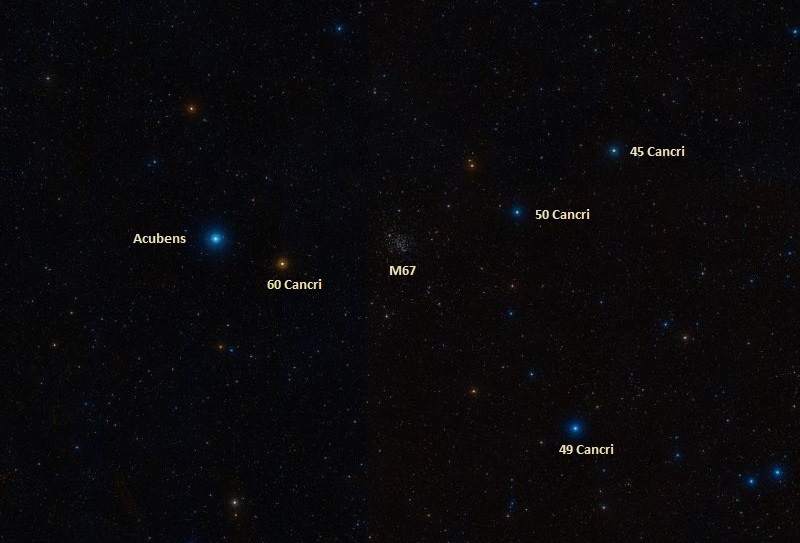Welcome back to Messier Monday! Today, we continue in our tribute to our dear friend, Tammy Plotner, by looking at the big snake - the King Cobra Cluster (aka. Messier 67).
In the 18th century, while searching the night sky for comets, French astronomer Charles Messier kept noting the presence of fixed, diffuse objects he initially mistook for comets. In time, he would come to compile a list of approximately 100 of these objects, hoping to prevent other astronomers from making the same mistake. This list – known as the Messier Catalog – would go on to become one of the most influential catalogs of Deep Sky Objects.
One of these objects is the open star cluster known as Messier 67, aka. the King Cobra Cluster. Located in the Cancer Constellation, and with age estimates ranging from 3.2 and 5 billion years, this cluster is one of the oldest clusters known. And at a distance of roughly 2610 and 2930 (800 - 900 pc) from Earth, it is the closest of any of the older open star clusters.
Description:
At 3.2 billion years, Messier 67 is billed as one of the oldest star clusters known and the oldest of all the Messier clusters. Containing perhaps 500 stars, and about 100 stars similar to our own Sun, this cloud contains no main sequence stars bluer than spectral type F, since the brighter stars of that age have already left the main sequence - no matter how it may appear! Among its 150 white dwarf stars, there's only about 30 blue stragglers...
[caption id="attachment_138774" align="aligncenter" width="580"]
Messier 67 (aka. the King Cobra Cluster), one of the oldest known open star clusters. . Credit & Copyright: Processing - Noel Carboni, Imaging - Greg Parker/NASA
[/caption]
As Xiao-Bin Zhan (et al) indicated in a
2005 study
:
As you look at this old open cluster, realize that it's a great study field for stellar evolution. As Jarrod R. Hurley (et al) explained in their
2005 study
:
History of Observation:
According to Johann Elert Bode, M67 was originally discovered by Johann Gottfried Koehler before the year 1779, but his telescope was so primitive that little more than the light could be made out. According to historical records his listed it as his object nineteen, describing it as, "A rather conspicuous nebula in elongated figure, near Alpha of Cancer."
Charles Messier independently rediscovered M67, resolved it into stars, and cataloged it on April 6, 1780: "Cluster of small stars with nebulosity, below the southern claw of Cancer." It was observed again by Caroline Herschel, and many times by Sir William, ending up getting its General Catalog designation for John Herschel. Of all the folks in history who described it... Dreyer said it best when he said it was a "Remarkable; cluster; very bright; very large; extremely rich."
Locating Messier 67:
Finding M67 is easy in both binoculars and a telescope once you've identified the upside down Y shape of the constellation of Cancer. Simply take aim at the easternmost star in the Y, and you'll find this delightful open cluster about a finger width to the west.
[caption id="attachment_138780" align="aligncenter" width="580"]
The location Messier 67 in the Cancer constellation. Credit: IAU and Sky & Telescope magazine (Roger Sinnott & Rick Fienberg)[/caption]
In binoculars and very small telescopes you'll spy a rich concentration that will appear almost galaxy-like, while larger apertures will fully resolve this cloud of stellar points. M67 is well suited to urban skies and moderate moonlit conditions.
Enjoy the magnificent M67 yourself!
And here are the quick facts on this Messier Object to help you get started:
- Object Name
-
Messier 67
- Alternative Designations
-
M67, NGC 2682
- Object Type
-
Open Galactic Star Cluster
- Constellation
-
Cancer
- Right Ascension
-
08 : 50.4 (h:m)
- Declination
-
+11 : 49 (deg:m)
- Distance
-
2.7 (kly)
Visual Brightne
- ss
-
6.1 (mag)
- Apparent Dimension
-
30.0 (arc min)
We have written many interesting articles about Messier Objects here at Universe Today. Here's Tammy Plotner's
Introduction to the Messier Objects
,
M1 – The Crab Nebula
, and David Dickison's articles on the
2013
and
2014
Messier Marathons.
Be to sure to check out our complete
Messier Catalog
. And for more information, check out the
SEDS Messier Database
.
Sources:
- *Messier Objects - Messier 67: King Cobra Cluster*
- *SEDS - Messier 67*
- Wikipedia - Messier 67
 Universe Today
Universe Today
